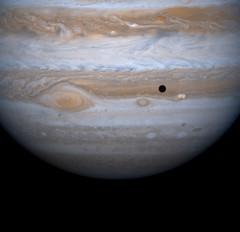
Photo courtesy of NASA: Jupiter's moon, Io, against the planet.
Linda Relyea
PR Department
In the next month many nearby planets will be visible. To assist in recognizing the planets, the Adams State College Zacheis Plan
etarium has scheduled “Planet Watch” for Saturday, March 3. The program includes a 20 minute presentation, at 6 p.m. and again at 7:30 p.m. There will also be telescopes available for viewing the planets and the moon. The event is free and open to the public.
The two brightest planets will be appearing in the western sky after sunset, and two others are making appearances in the east. On any clear evening, after sunset, Jupiter and Venus appear in the western sky, both are brighter than any star and Venus is the brightest one.
Over the next month or so, Jupiter will move closer to Venus, making its closest approach around March 13. A thi
n crescent moon joins them on the evenings of February 25 and 26, and again on March 25 and 26. Mercury will appear low on the western horizon shortly after sunset, at its highest around March 6.
At the same time the eastern sky is showcasing Mars and Saturn. Mars has a definite reddish tint and can be seen rising over a low eastern horizon around 6:45 p.m. in late February, earlier in the first week of March. Saturn is later, rising after 10 p.m. in late February. By late March it will rise just after 9 p.m. Saturn has a yellowish tint and will be shining about as brightly as nearby star Spica.
Steadily held binoculars will show moons orbiting around Jupiter. With a small telescope you will be able to see colored bands in the clouds of Jupiter, and Saturn’s rings as well as some of its moons.
For further information, email Dr. Robert Astalos at rjastalos@adams.edu.
What’s Been Said…